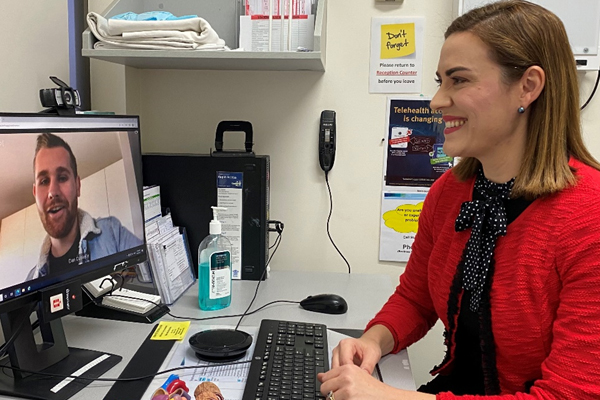“It needs to be more than a seat at the table; it needs to be a voice”: Partnering with consumers to optimise telehealth

Clinician and patient communicating via telehealth services.
Despite being available for many years, the COVID-19 pandemic forced the rapid upscale of telehealth services across Metro North Health back in early 2020. Clinician-researchers from the RBWH Allied Health Professions evaluated this experience, from the perspectives of consumers, clinicians and administrative staff, to better understand how we could enhance and sustain telehealth services post-pandemic (study findings can be accessed here). We heard that consumers had an overall positive experience accessing their care via telehealth and would like this option to continue outside of the COVID-19 restrictions. We heard that clinicians and administrative staff faced many challenges with the rapid conversion to telehealth, including insufficient infrastructure for example, computers with web cameras, private clinical spaces, inefficient workflow processes, and limited training in both how to use the telehealth platform and how to adapt clinical care to a virtual medium.
While many of these staff challenges have been addressed, service delivery has largely ‘rebounded’ back to in-person care once physical distancing restrictions were lifted. This is not unique to our health service and has been observed both nationally and internationally. Findings suggested that the how, when and where telehealth services are provided to patients is predominantly driven by a single service or individual clinician, limiting the opportunity for consumers to engage and collaborate in how care should be accessed.
As such, this follow-up project is seeking to understand consumers’ experiences and determine what is required to influence awareness and advocacy for expanding telehealth options as part of patients’ healthcare journey.
Stage 1 (exploratory phase) of a three-stage experience-based co-design process has been completed to date. Eleven services with established telehealth models were sampled from across Metro North Health. Thirty-three consumers from these services spoke about their experiences regarding how telehealth was introduced and how their appointments were organised and conducted.
Overall, consumers felt prepared and informed before their telehealth appointments, however noted clinics used different modes to communicate appointment information. Communication around how to connect to their telehealth appointment was minimal but adequate for most consumers. Some consumers reported needing additional support depending on whether they were “tech savvy” or not.
Care provided via telehealth was reported by patients to be “as good as in-person”, with minimal wait times and most care needs met. Despite acknowledging its clear benefits, many consumers were not involved in the decision to receive care via telehealth, nor offered an opportunity for family or caregivers to attend appointments. Choice regarding continuing with the service, and how future appointments were accessed was also minimal amongst the consumers interviewed.
While consumers continue to describe a positive experience, findings highlight several opportunities to improve person-centred care and the digital health experience, by enhancing telehealth communication, messaging and choice for consumers and their loved ones. These issues are being explored in Stage 2 of the experience-based co-design process.
We would like to formally acknowledge and thank Metro North Health, Healthcare Excellence and Innovation (HEI) for financially supporting Stage 1 of this project, as well as all of the staff and consumers who provided their time in speaking with us.
